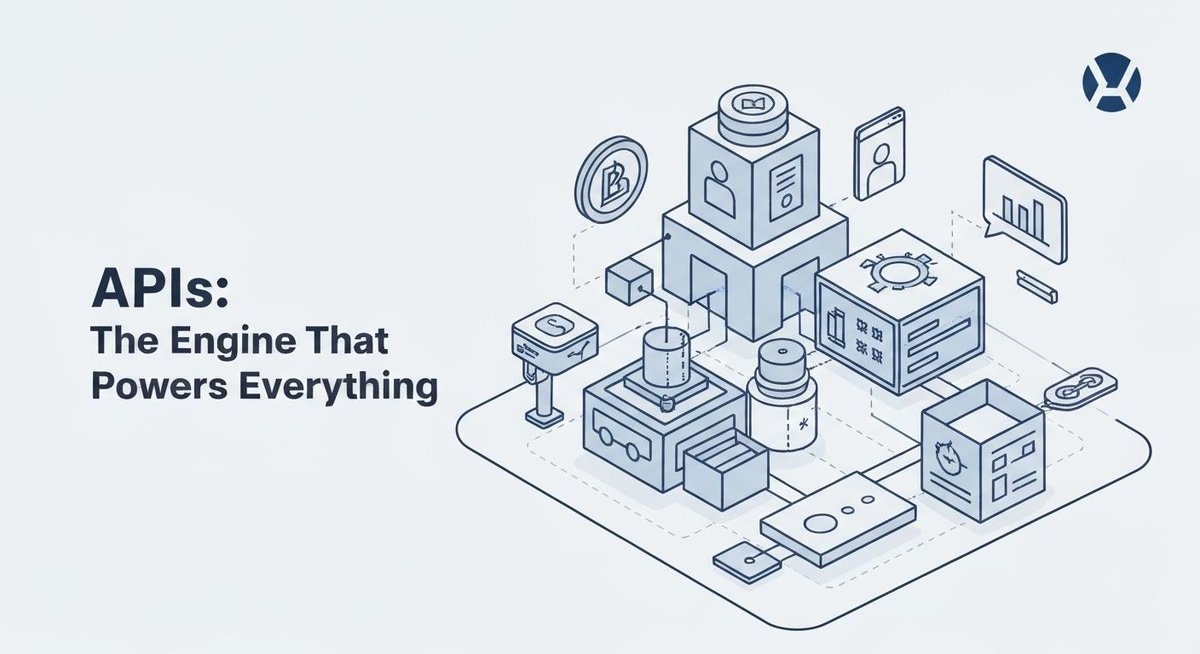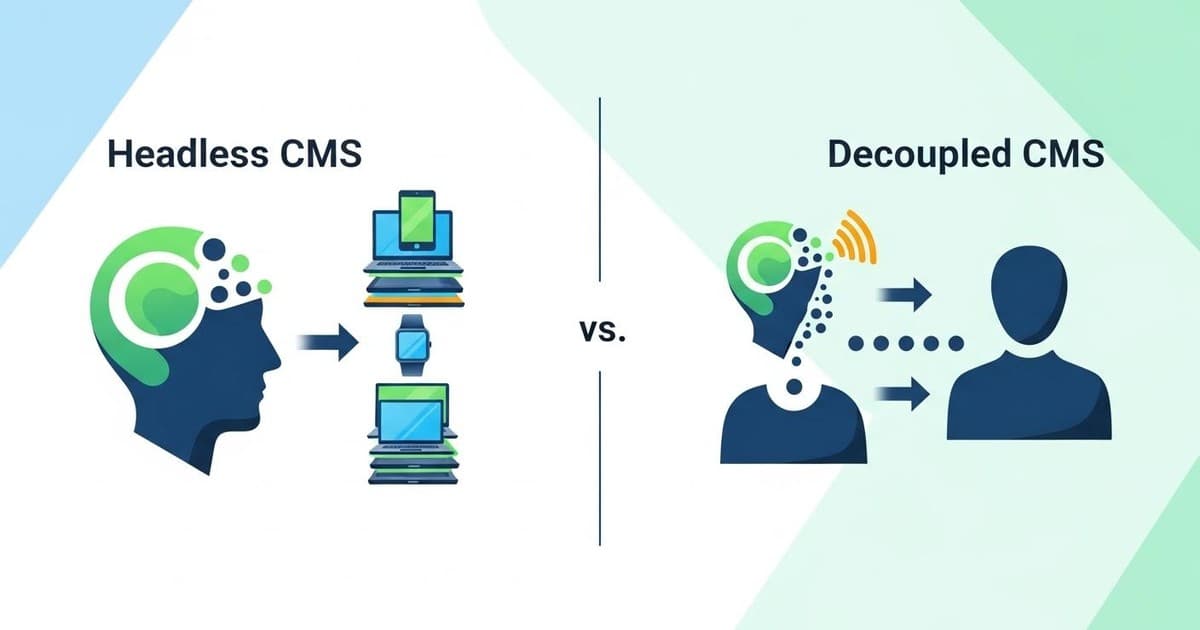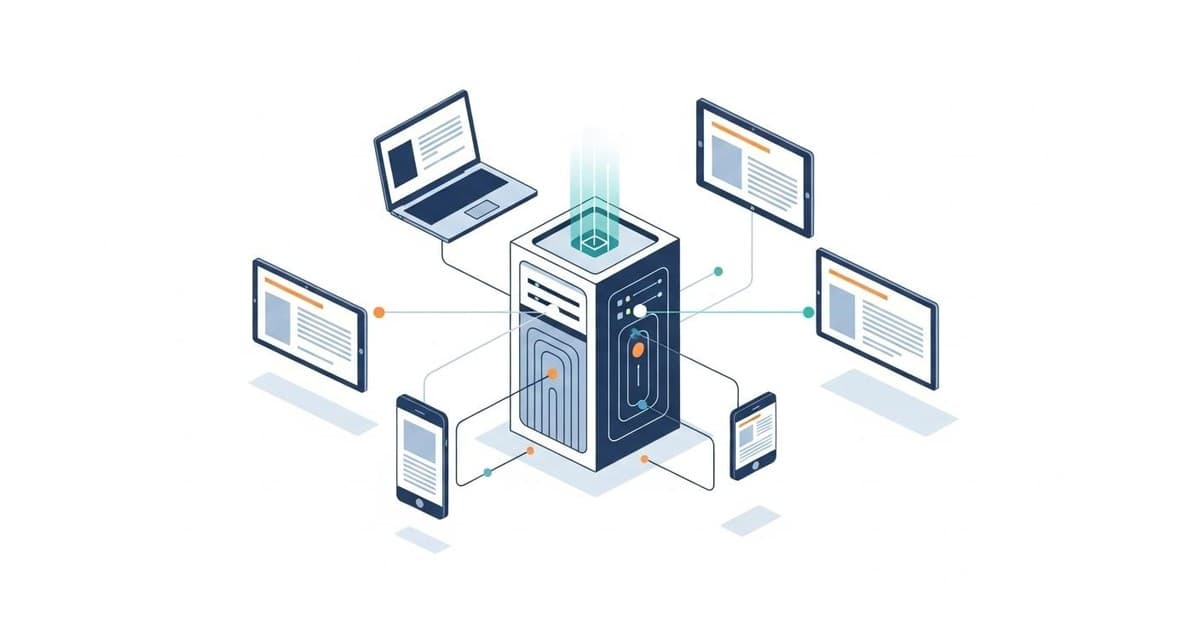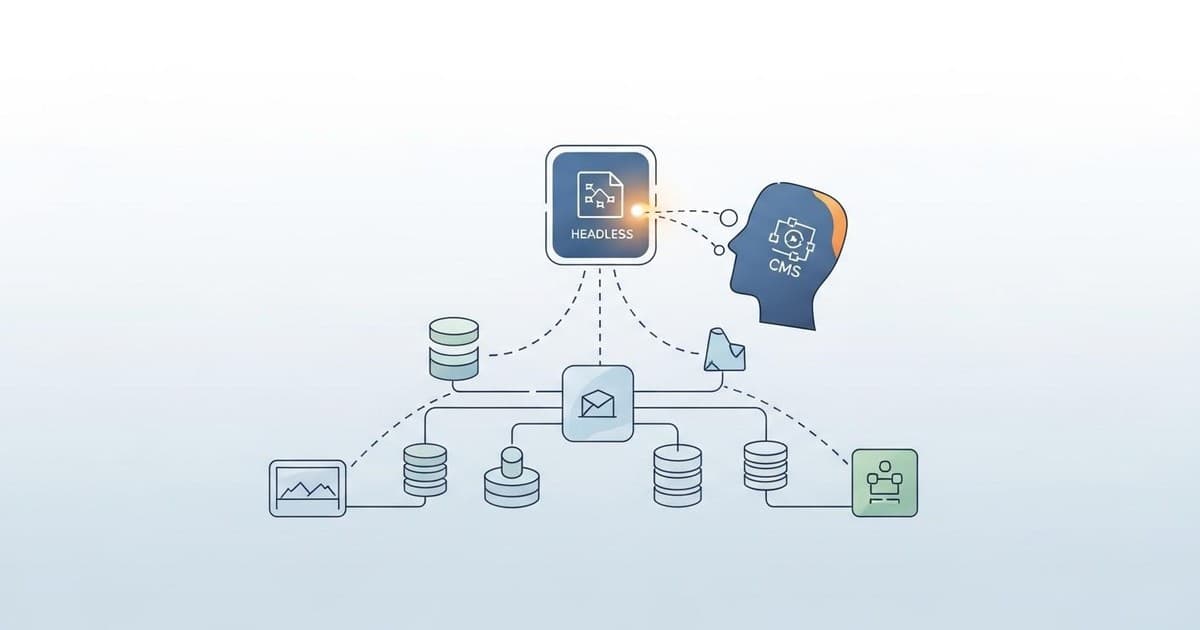
Headless CMS Architecture: Seven Things You Need to Know
"Headless" is a big deal in content management systems (CMSes), but it might've slipped past you with all the tech jargon out there. No worries! We're gonna break it down so you can chat about it with your dev team like a pro.
First off, what's this "headless" thing all about? Imagine your CMS as a body. The "head" is the part that deals with how your content looks on the front-end (like your website). In a headless setup, we chop off that head (sounds brutal, right?), leaving just the body to manage your content.
So why do this? Well, it makes your content super flexible. You can send it anywhere - websites, apps, smart fridges, you name it! Plus, it gives developers more freedom to work their magic on the front-end.
We'll dive deeper into why headless is cool and how it can make your life easier. Stick around, and you'll be dropping headless knowledge bombs in no time! Let's get this party started!The Core Concept: Decoupling Content from Presentation
Headless Defined
Think of headless architecture as a fancy way of building apps where the brains and the looks are totally separate. It's like having a super-smart robot (the back-end) that can wear any costume it wants (the front-end).
In this setup, the "head" (aka the pretty part users see) is optional or DIY. The back-end is like a content buffet, storing all your goodies - text, pics, videos, you name it. And here's the cool part: this content can go anywhere! Websites, apps, smart toasters, whatever!
APIs are like the matchmakers, helping the front-end and back-end chat. This whole setup makes life easier for non-techies too. No more tangled code spaghetti!
The best part? You can build one app and then easily send it on vacation to other devices or platforms. Same brains, different outfits - no extra coding acrobatics needed!
So, headless architecture is like having a Swiss Army knife for your digital content. Flexible, powerful, and ready for anything! The Contentful platform exemplifies this approach, providing robust APIs that developers can integrate with virtually any frontend technology.
Before Headless Architecture
So, if headless architecture rings a bell, you might be thinking of its cousins: best-of-breed, microservice, or that fancy MACH thing (microservice-based, API-first, cloud-native, headless). They're all part of the same cool crowd.
These guys are all about mixing and matching the best tools for the job, instead of going for those all-in-one packages. It's like building your own custom burger instead of grabbing a combo meal.
Now, the opposite of this headless party is what we call monolithic architecture. It's like those all-inclusive resorts where everything's bundled together. In the tech world, this means the front-end (what you see) and back-end (the brains) are super glued together.
Monolithic setups are great for those "website in a box" deals. You get everything you need to launch a site - CMS, design tools, SEO stuff, shopping cart - all in one neat package. It's perfect for getting a site up and running faster than you can say "launch party!"
Advantages and Disadvantage to a Monolithic Approach
So, monolithic architecture is like getting a Happy Meal - everything's there, ready to go, from one place. It's perfect if you're just starting out or don't need a ton of content. Plus, if something goes wrong, you know exactly who to call (no ghostbusters needed).
But here's the catch: if your business is growing faster than a teenager in a growth spurt, monolithic might start feeling like a tight pair of shoes. Why? Because it's not super flexible. Changing content can be a pain, like trying to fit a square peg in a round hole.
This setup also means your content is kinda stuck where it is. Want to show it off on different platforms? Good luck! You'll be copying and pasting like it's your job (and nobody likes that).
Now, headless architecture? That's like having a buffet where you can mix and match whatever you want. It gives you the freedom to create killer experiences for your audience, however and wherever you want.
Seven Features for Headless Architecture
So, we've chatted about what headless architecture is and why it's the cool kid in content management. Now, let's dive into what makes it tick!
Think of this as opening up the hood of a sweet ride. We're gonna check out all the shiny parts that make headless architecture purr like a kitten. Get ready to geek out (in a totally cool way) over the features that make this tech so awesome.
1. APIs: The Engine That Powers Everything
So, a headless CMS is like a content vending machine on steroids. It's all about Content as a Service (CaaS) - fancy talk for "give me content when I ask for it." No more pre-made web pages; just pure, raw content goodness.
Here's how it rolls: developers ask the CMS for stuff using APIs (think of them as magic spells). The CMS spits back exactly what they need. Want your latest blog posts? Zap! Need product info? Bam! It's like ordering à la carte instead of getting the whole buffet every time.
 Most of these cool cats offer REST and GraphQL APIs. GraphQL is the new hotness 'cause it's super efficient. It's like ordering a custom pizza instead of buying separate ingredients.
Most of these cool cats offer REST and GraphQL APIs. GraphQL is the new hotness 'cause it's super efficient. It's like ordering a custom pizza instead of buying separate ingredients.
The best part? These APIs speak every language. Your website, mobile app, and admin dashboard can all grab the same content, but dress it up however they want. It's like having a universal translator for your digital stuff.
This whole API-first thing turns your content into a shape-shifter, ready to pop up anywhere, anytime. Pretty neat, huh? Decipher's CMS leverages this architecture to increase marketing team efficiency by eliminating the need to recreate content for different platforms, letting teams focus on strategy rather than repetitive content management tasks.
2. Omni-Channel Publishing
The internet's not just about computers anymore. We've got apps, smartwatches, Alexa, and even VR stuff. The old way of doing things just doesn't cut it.
Here's where headless architecture shines: it lets brands easily create content for all these different gadgets. It's like being everywhere at once!
 Old-school systems like Drupal or WordPress? They're kinda stuck in the past. They were built for websites, so they struggle with all these new devices. It's like trying to fit a square peg in a round hole.
Old-school systems like Drupal or WordPress? They're kinda stuck in the past. They were built for websites, so they struggle with all these new devices. It's like trying to fit a square peg in a round hole.
You could use a different system for each new device, but that's a headache waiting to happen. More stuff to manage, more work for everyone, and way more expensive.
The smart move? Go headless. Create your content once, and boom - it works everywhere. That's why a lot of online stores are jumping on this bandwagon. It lets them launch new stuff super fast and easy.
So, if you want to keep up with all these new gadgets and stay ahead of the game, headless architecture is the way to go. It's all about being flexible in this crazy digital world!
3. Integration with Other Tools
So, another big reason companies are going gaga for headless architecture is that it plays nice with other tools. It's like the ultimate team player!
Imagine you've got this cool LEGO set, but instead of just LEGO pieces, you can use any blocks you want. That's headless architecture for you. You can mix and match open-source stuff, third-party tools, or even build your own custom pieces. It's all about creating your perfect tech playground.
Each of these tools is like a superpower you can add to your digital Swiss Army knife. Need a new feature? Just plug in the right tool. Want to change things up? No problem, just swap out the pieces you don't need anymore.
The best part? This setup is totally future-proof. You can use the coolest tools today and easily upgrade when even cooler stuff comes out tomorrow. It's like having a crystal ball for your tech needs!
Now, compare this to the old-school monolithic platforms. They're like those pre-built playsets - sure, they look nice, but you're stuck with what you get. Want something new? You've gotta wait for the company to add it, or try some risky DIY that might cause problems down the road.
4. Pick Your Language
Headless architectures are like a playground for developers. They can use whatever programming languages and frameworks they want. It's a whole different ballgame compared to the old-school systems.
With traditional CMSs, you're stuck using whatever the software company decided on. Sure, these systems try to do everything, but they end up being a jack of all trades, master of none.
In the headless world, developers can pick and choose what works best for each project. Frontend folks might mix it up with React or Vue.js, while the backend crew could go for JavaScript, Express.js, or Nest.js. It's all about using the right tool for the job.
This flexibility doesn't just make content creation smoother. It also makes life easier for the whole team. And when people aren't frustrated with their tools, they're more likely to stick around. Happy developers, happy company, right?
5. Agile Workflows
Headless architectures are like speed boosters for getting stuff done. They're not just flexible with tech stuff, they also support agile workflows. That's a big upgrade from the old-school waterfall approach where you had to do things in a strict order.
So how does this agility magic work? Well, in a headless setup, you've got these little teams handling different parts of the system. They're like independent squads that can do their own thing without messing up everyone else's work. Need a new feature? These teams can whip it up and roll it out without waiting on the whole gang.
In the old monolithic systems, different teams would work separately, like they were in different bubbles. But with headless, it's more like a collaborative party. The creative folks can be cranking out content while the tech wizards are tweaking code, and nobody's stepping on each other's toes.
This teamwork approach means brands can act on user feedback super fast. It's like hearing what your customers want and making it happen in record time. Better experiences, happier customers, everyone wins.
6. It Supports Structured Content
Headless architecture isn't just a win for the tech crowd - it's a game-changer for everyone who deals with content. One of its coolest tricks? Structured content.
Think of it like this: instead of your content being stuck in one layout, it's broken down into little Lego pieces. You've got your headers, body text, images, and so on. You can mix and match these pieces to build bigger stuff like hero banners, author bios, or blog posts. The best part? You can use these anywhere without worrying if they'll fit.
This setup is a lifesaver when you're moving content around. No more endless copying and pasting, which means fewer oopsies from human error. It's also easier for search engines to understand, and you can personalize or translate it without breaking a sweat. All of this means better SEO and an easier time reaching new markets.
7. Support of Composable Commerce
Headless architectures are like a Swiss Army knife for businesses, but they're especially awesome for online shops. In fact, more and more companies are jumping on the headless commerce bandwagon these days.
Enter composable commerce - it's like building your dream online store with digital Lego blocks. You get to pick and choose all the cool features you want. Need a content management system? Pop it in. Shopping cart? Add it to the mix. Checkout and payment stuff? Throw that in too. It's all about making your perfect online shop setup.
New Responsibilities and Considerations
Let's face it, if you're running a modern, growing brand with a busy digital content schedule, you need something more flexible than your old-school setup. That's where the headless approach comes in handy.
But why stop there? If you really want to future-proof your brand, keep your customers hooked, and stay quick on your feet with innovative digital experiences, it's time to embrace composability.
Decipher is here to help you ditch that clunky traditional CMS and give your marketing operations a fresh makeover. We're talking customizable freedom for every part of your tech stack. You get to play with a huge selection of apps and plugins, shape your content experiences down to the tiniest detail, and get creative with structured content across any digital channel.
Whether you're running a website or an online store, Decipher's got your back. We'll help you gear up for whatever curveballs the future might throw your way. So, ready to level up your digital game?
Cost considerations extend beyond the obvious software licensing fees. You need to account for the headless CMS service, frontend hosting costs, development resources for initial setup, ongoing maintenance, and the time investment in training your team. However, enterprise-ready solutions often provide better long-term value by eliminating the need for multiple specialized tools and reducing technical debt.


